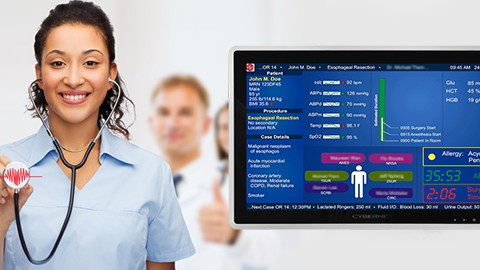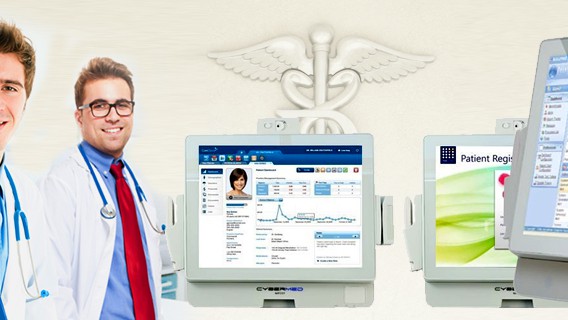We’ve discussed burnout several times on this blog and for good reason. It’s a pervasive issue that strikes both nurses and physicians. As such, issues that contribute to this burnout, especially during this incredibly trying moment in medical history, deserve to be brought into the spotlight and troubleshot.
Changes in work environments and medical hardware such as medical grade computers can surely help chip away at the stress that whittles away at healthcare staff; However, what makes burnout in nurses and physicians so systemic and not an isolated issue is that, many times, it’s caused by one of the most necessary and integral parts of the caregiving process: note taking. As such, effective clinical documentation improvement programs have remained an ever elusive ideal in the healthcare space, the deciphering of which promises improved efficiency, enhanced patient care, more human connection between patient and physician, and, more importantly, the alleviation of stress on care staff.
What is Clinical Documentation Improvement?
Article Guide
Clinical documentation improvement, or clinical documentation integrity, is a collection of best practices used to promote complete accuracy and comprehensiveness of documentation on any given patient recorded by a provider. Data recorded on a patient with these practices is coded and then used to inform everything from quality reporting and condition tracking to accurate reimbursement and even public health records. Employed effectively, a clinical documentation improvement program can prevent HIPAA compliance issues, financial burden, and even inaccurate patient care.
And so, with proper documentation impacting so many facets of patient care, it’s easy to see why clinical documentation improvement remains a constantly sought after ideal. So, what gets in the way?
What are the Main Challenges to Clinical Documentation Improvement?
EHR compatibility issues are no breaking headline in the world of healthcare. In fact, EHR physician burnout is one of the most common forms of healthcare staff burnout because of the sheer volume and redundancy of documentation that needs to be carried out for each individual patient. Oftentimes, the volume of these notes are so demanding that it causes staff to neglect the personal approach to care and compromise on empathetic treatment and eye contact. And regrettably, the need to speed through these notes in order to gather all of this information often results in documentation and patient records that lack “narrative”.
According to Chief Nursing Officer Jeri Ann Kelly, EHR records that often prompt physicians to simply check off boxes or provide simple “yes or no” answers creates a record that hardly delivers the full story behind a patient’s healthcare journey. She comments, “you cannot write an appeal letter based on checkboxes”, highlighting the fact that patients can often be denied treatments they could seriously benefit from because their whole story is being expedited and abridged into yes-no answers that don’t illustrate exactly what they need from their care.
The Solution: Clinical Documentation Improvement Examples
Fixes to the way EHRs are created as well as their interoperability are out of the control of most care facilities, but that doesn’t mean clinical documentation improvement examples don’t exist. Below are a few policy, software, and hardware-based solutions we’ve seen employed with resounding success that could stand to benefit your facility as well.
1.) SOAP Notes/Standardized Notes
SOAP Notes are a format for note taking we’ve mentioned before and still believe hold merit in today’s healthcare industry that struggles with clinical documentation improvement. SOAP notes essentially break down patient notes into 4 key sections: Subjective, Objective, Assessment, and Plan. By cleanly organizing notes in this way, there are clearly labeled sections a physician can jump to when reading a patient’s notes.
Even more importantly, the “Subjective” section of these notes open the door for more of that narrative mentioned by Jeri Ann Kelly. By allowing physicians to include more information about their impressions, interactions with patients, and other general information, billers, out of network providers, and other care staff within your facility can receive a bigger picture look at the patient in question, allowing for a more comprehensive patient record and better continuum of care.
SOAP notes are only one example of standardized note taking practices that could stand to improve clinical documentation improvement efforts. The goal of whatever standardized note process you implement should be streamlining the process to alleviate burnout while also promoting more narrative in the notes recorded to improve patient outcomes and accuracy.
2.) AI Scribes
On the topic of alleviating burnout, AI-based scribing programs have proven time and time again their ability to streamline the documentation process and remove some of the burden behind inputting data manually. One need just look at examples such as Dr. Matthew Fradkin’s implementation of an AI scribe program to draw inspiration.
By implementing a program capable of picking up on his individual note taking style and preferences, Dr. Fradkin’s AI scribe is able to automatically record important notes as they’re spoken aloud by both patient and physician. Meanwhile, off-site there is a reviewer who can scrub through these notes for accuracy while also organizing the data into proper sections in much the same way as a physician would do manually when using a standardized note taking procedure like SOAP notes. Dr. Fradkin even went on to emphasize that implementing this solution allowed him to see over 35% more patients as a result of the streamlined documentation solution without having to compromise on the quality of those notes and visits.
Of course, facilities looking to implement this solution aren’t strictly limited to Dr. Fradkin’s system either. We’ve discussed before how facilities like Nebraska Medicine have been able to integrate widely available voice technology in order to cut down on transcription costs while also improving documentation quality.
3.) Hardware-Based Solutions
Finally, optimizing workstations so that they provide a streamlined, optimized approach to patient note taking can also make a world of difference in the world of clinical documentation improvement.
Something as simple as investing in a larger monitor can give physicians more space to work with, alleviating the stress of cluttering several, information-dense windows on one screen and exponentially raising the likelihood of inaccurate or missing notes.
Medical grade monitors that are IE60601-1 and IP65 certified can provide screen sizes up to 24 inches with 4K resolution while also being certified safe to use near patients, not only providing more screen space, but also providing better resolution with which to analyze charts and scans more efficiently and accurately.
Create a Clinical Documentation Improvement Program Built For Your Facility
Obviously, creating a clinical documentation improvement program takes work and an iterative process. Since the issue, like we mentioned, is more systemic than it is individual, it’ll take some playing around with solutions like the ones we mentioned above before a fix that fits with your facility can be found. Once that tailored fix is found, however, the benefits you’ll observe are sure to be well worth the investment. For more information on how you can get started creating a clinical documentation improvement program built for your facility, contact an expert from Cybernet today.
Why Fanless Medical Computers are a Must for the Medical Profession
July 9, 2015
The enterprise industries and the healthcare profession have been greatly affected by the increasing use of all-in-one computers and similar devices. The healthcare profession has grown to rely more and more on medical…
0 Comments5 Minutes
How Medical Grade Computers Improve the Standard of Care in the Medical Profession
August 3, 2015
The face of the healthcare industry has changed drastically in the past decade. Now, the use of devices like medical grade computers in patient rooms, emergency rooms, and operating rooms have allowed healthcare service…
0 Comments6 Minutes
How Medical Grade Computers Are Benefitting Chiropractic Clinics
November 13, 2015
Man and machine are made to complement each other, especially when it comes to medicine. They go hand by hand, which is why professionals work with high-end equipment to produce fast, accurate data. This, in return,…
0 Comments4 Minutes
You Can't
Learn from a Pop-up
But we can deliver knowledge to your inbox!
We dive deep in the industry looking for new trends, technology, news, and updates. We're happy to share them with you.
Knowledge, News, and Industry Updates Right in Your Inbox





